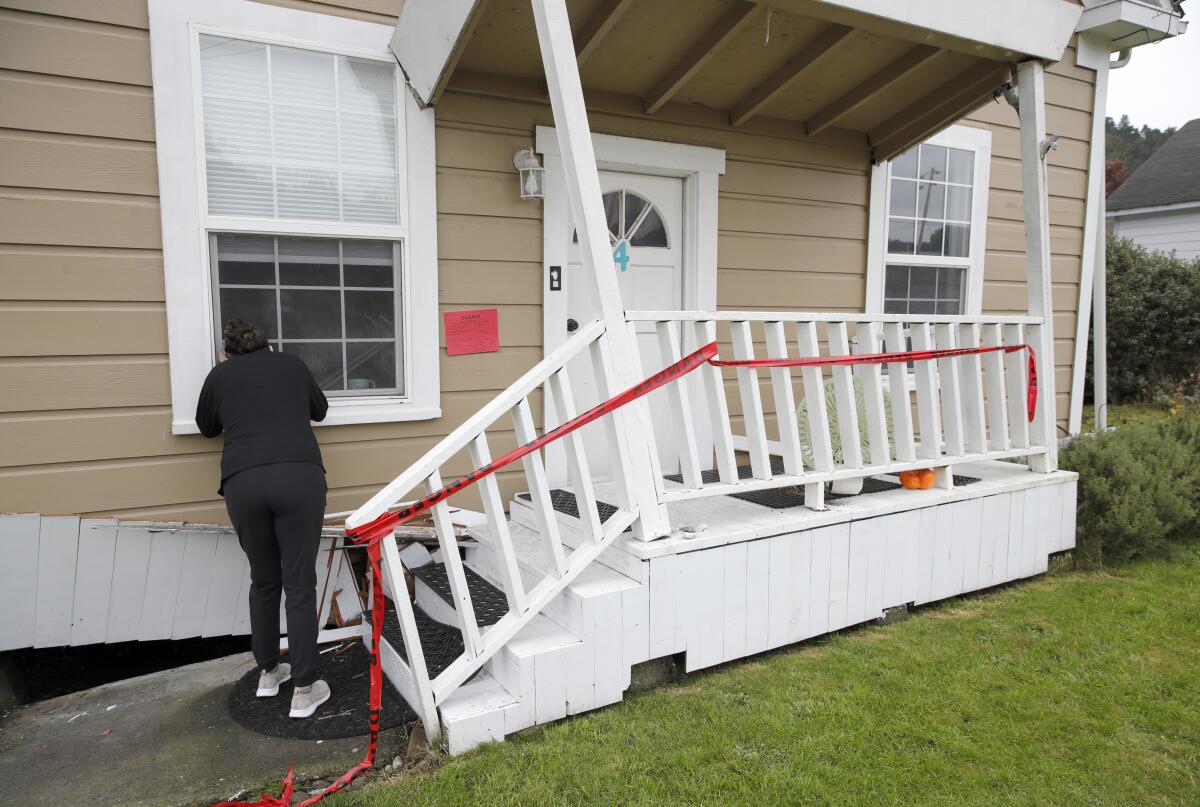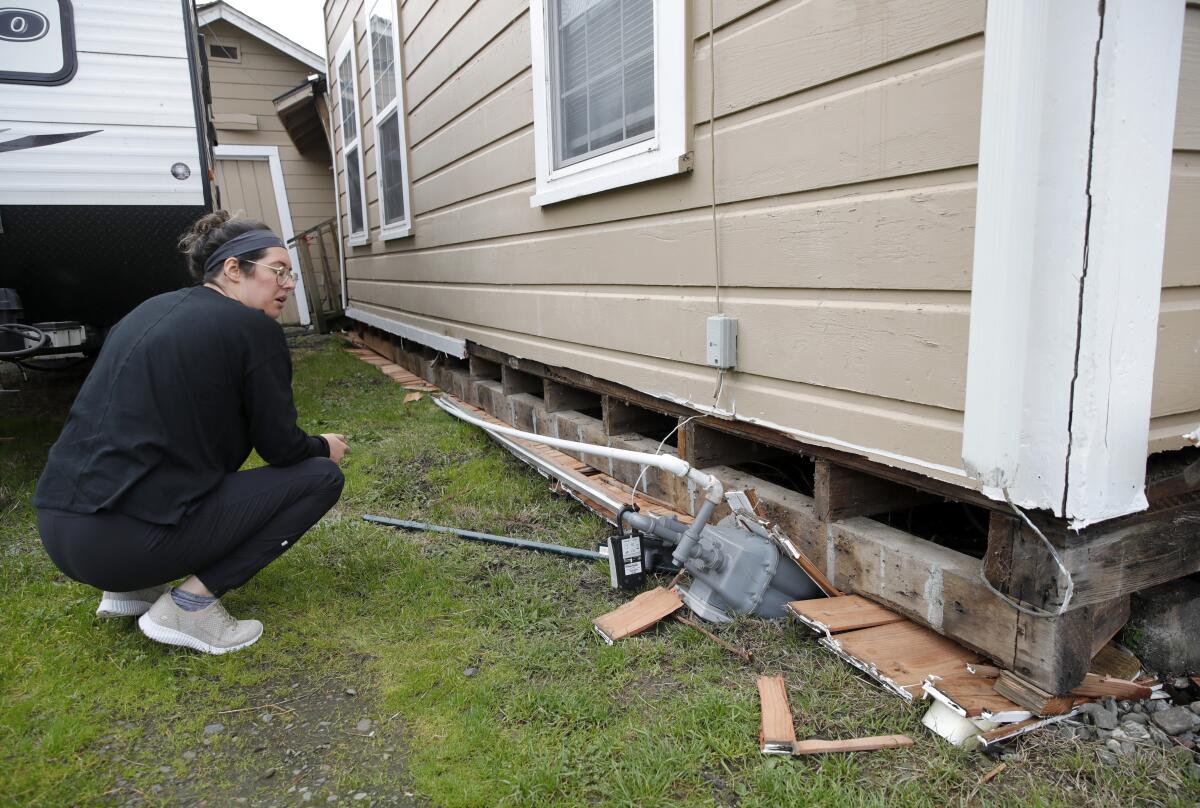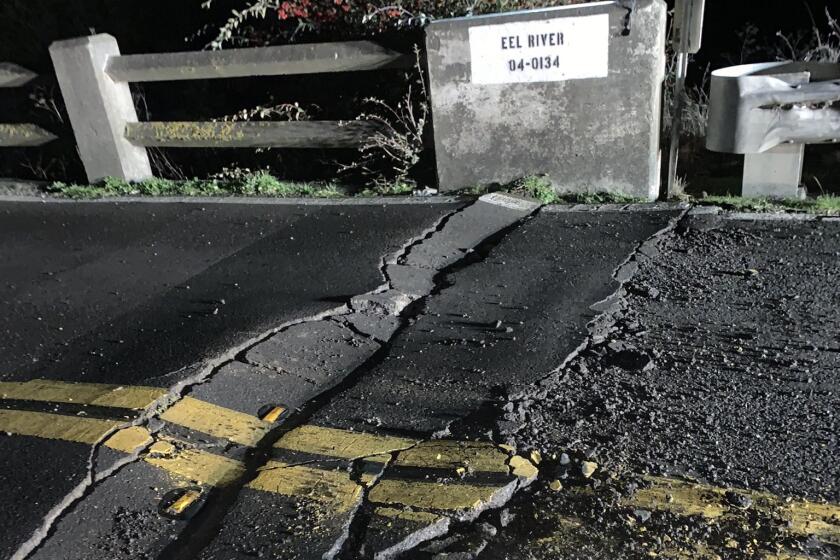‘An earthquake can drop in’: More than 1 million California homes need retrofittings

- Share via
Jacqui and Shane McIntosh were looking to sell their two-bedroom, single-family home in Rio Dell, Calif., so they could move closer to work. When a potential buyer scheduled a visit to their property this week, the couple hoped it might result in an offer.
But hours before the buyer was set to arrive Tuesday, a magnitude 6.4 earthquake struck Humboldt County, jolting the couple awake in the middle of the night and knocking them to the ground. Jacqui McIntosh, 28, recalls clinging on to one of the legs of the bed as they were being tossed around.
She said it was only after they exited the house that they realized how bad the damage truly was.
“Our porch was higher than our house,” she said. “When we got down, our gas line is right next to the door, and we got hit with natural gas and propane. On the other side, there was water going everywhere because the water main broke.”
Earthquake adds to hardships for some Northern California residents while others quickly bounce back.
After their street was evacuated because of the gas leak, the McIntoshes returned home to try to find their cats and other pets and realized the house had been red-tagged.
The couple, who work for a company that makes recreation and military rafts, had applied for a grant to earthquake-retrofit their decades-old home under the state’s Earthquake Brace and Bolt program. They got an email Sunday, two days before the temblor, informing them that they’d hear in February whether they’d been selected for the grant.
“It’s always been in the back of my mind,” McIntosh said. “It’s so expensive and we financially couldn’t do it. We set a path for [the new homeowner] to get the house retrofitted by the state but it was too late.”
McIntosh said they also filed a claim with their insurance company but were notified it had been withdrawn because they don’t have earthquake insurance due to the cost.
“We have a huge lawn ornament that we are now responsible for,” McIntosh said. “Unless some sort of government aid comes through, it’s now solely on us to fix the house. It’s a real possibility that we might have to just walk away, ruin our credit, go bankrupt and start all over again.”

Unfortunately, the McIntoshes’ experience is not a rare one. In a state known for its earthquakes, many homes lack retrofitting and insurance.
Today, fewer than 1 in 7 California homeowners have earthquake insurance, according to the California Earthquake Authority, and more than 1 million homes in the state need to be structurally retrofitted.
In Northern California, such a retrofit can cost upward of $5,000, said Janiele Maffei, a structural engineer and chief mitigation officer for the California Earthquake Authority.
Humboldt County has specific structural challenges to its homes, because the region is so moist, Maffei said. Many of the homes there have “post and pier” foundations, meaning they don’t have a continuous concrete foundation around the perimeter of the house. Instead, the homes are supported by posts on concrete with a skirt around it, in order to give the residence access to air. Putting in a whole new perimeter foundation can cost between $10,000 and $15,000.
Under the Earthquake Brace and Bolt Program, homeowners can apply for a grant of up to $3,000 for seismic retrofitting. There’s also additional funding for low-income homeowners making up to $72,080 per household.
In the case of the McIntoshes’ home, the earthquake had knocked the house off of its foundation and made it unstable. Retrofitting would involve either bolting the house’s frame to its foundation or adding braces to the walls in the space beneath the first floor.
Registration for the retrofitting program ended Nov. 29, and about 169 households from Humboldt County applied. Maffei said randomized selection for the program is expected to take place in the next few months. She encouraged those who are placed on a wait list to not lose hope, because about 50% of people in the program end up dropping out.
Restoring a home that has fallen off its foundation involves putting up steel beams, picking up and moving the house to where it’s supposed to be and building a new foundation underneath, Maffei said. The process can cost hundreds of thousands of dollars.
“My heart goes out there to these families who are displaced,” she said. “An earthquake can drop in on the worst week of someone’s life. It doesn’t just drop in on the healthy and young who are financially prepared to survive that. It drops in on real life and can be catastrophic.”
A 6.4 earthquake near Ferndale has resulted in at least two deaths from medical emergencies, 11 injuries and extensive damage.
Californians can also prepare their homes for earthquakes by anchoring the contents of their house, including televisions, bookshelves, microwaves, cabinets and other appliances. Beds should be moved away from windows because of the risk of glass shattering. Heavy objects and frames near the bed should also be removed.
Insuring that your gas heater is secured to the wall and installing an automatic valve that shuts off the gas during an earthquake could decrease the chances of a leak or subsequent fire.
Chimneys also pose a significant hazard during earthquakes and could be removed or retrofitted to ensure safety.
McIntosh and her husband have been staying in a corporate condo that her company had offered to them. The days immediately after the quake have involved picking up the pieces of their lives, including locating and securing a place to stay for their pet pot-bellied pig, Elvis Pigsley, who used to reside in their backyard.
McIntosh’s sister set up a GoFundMe page for the couple, who are waiting to hear if the Federal Emergency Management Agency will be able to provide any disaster relief or other financial assistance.
“People are living paycheck to paycheck,” she said. “They can’t afford earthquake insurance. We’re not the only ones sitting out there going ‘How am I gonna fix this?’ And that’s the scary part.”
More to Read
Sign up for Essential California
The most important California stories and recommendations in your inbox every morning.
You may occasionally receive promotional content from the Los Angeles Times.













